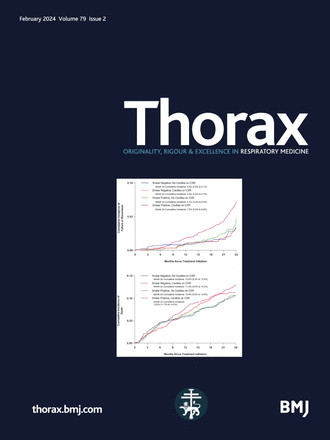从学龄期到成年期的肺功能轨迹及其与心血管疾病风险指标的关系
IF 9
1区 医学
Q1 RESPIRATORY SYSTEM
引用次数: 0
摘要
理由 成年早期的肺功能与随后的不良健康后果有关。目的 确定能否在不同人群中得出稳定且可重复的肺功能轨迹,并研究其与心血管结构和功能的客观指标之间的关联。方法 我们利用潜在轮廓模型,研究了三个基于人口的出生队列,这些队列拥有从儿童期到成年早期的重复肺活量数据,以确定 1 秒用力呼气容积(FEV1)/用力肺活量(FVC)的轨迹。我们使用多叉逻辑回归模型来研究衍生轨迹的早期预测因素。然后,我们在一个队列中确定了约 3200 名 24 岁参与者的 FEV1/FVC 推导轨迹与血压和超声心动图标记物之间的关联程度,这些标记物可增加心血管风险和中风。结果 我们确定了四种 FEV1/FVC 轨迹,这些轨迹在不同队列中具有惊人相似的潜在特征(汇总样本数=6377):高于平均水平(49.5%);平均水平(38.3%);低于平均水平(10.6%);持续偏低(1.7%)。在所有队列中,男性性别、喘息、哮喘诊断/用药和过敏反应都与肺功能减退的轨迹有关。我们发现有证据表明,随着 FEV1/FVC 的降低,超声心动图确定的心血管风险指标(包括左心室质量与身高的指数和颈动脉内膜中层厚度)也会增加(每个轨迹的平均粗效应 p 值从 0.10 到 p 不等)。如需查询MAAS、IoW、SEATON或Ashford的数据,请联系Philip Couch philip.couch@manchester.ac.uk)。本文章由计算机程序翻译,如有差异,请以英文原文为准。
Lung function trajectories from school age to adulthood and their relationship with markers of cardiovascular disease risk
Rationale Lung function in early adulthood is associated with subsequent adverse health outcomes. Objectives To ascertain whether stable and reproducible lung function trajectories can be derived in different populations and investigate their association with objective measures of cardiovascular structure and function. Methods Using latent profile modelling, we studied three population-based birth cohorts with repeat spirometry data from childhood into early adulthood to identify trajectories of forced expiratory volume in 1 s (FEV1)/forced vital capacity (FVC). We used multinomial logistic regression models to investigate early-life predictors of the derived trajectories. We then ascertained the extent of the association between the derived FEV1/FVC trajectories and blood pressure and echocardiographic markers of increased cardiovascular risk and stroke in ~3200 participants at age 24 years in one of our cohorts. Results We identified four FEV1/FVC trajectories with strikingly similar latent profiles across cohorts (pooled N=6377): above average (49.5%); average (38.3%); below average (10.6%); and persistently low (1.7%). Male sex, wheeze, asthma diagnosis/medication and allergic sensitisation were associated with trajectories with diminished lung function in all cohorts. We found evidence of an increase in cardiovascular risk markers ascertained by echocardiography (including left ventricular mass indexed to height and carotid intima-media thickness) with decreasing FEV1/FVC (with p values for the mean crude effects per-trajectory ranging from 0.10 to p<0.001). In this analysis, we considered trajectories as a pseudo-continuous variable; we confirmed the assumption of linearity in all the regression models. Conclusions Childhood lung function trajectories may serve as predictors in the development of not only future lung disease, but also the cardiovascular disease and multimorbidity in adulthood. Data are available upon reasonable request. The informed consent obtained from all included participants does not allow the data to be made freely available through any third party maintained public repository. However, data used for this submission can be made available on request to the corresponding cohort executive. The ALSPAC website provides information on how to request and access its data (
求助全文
通过发布文献求助,成功后即可免费获取论文全文。
去求助
来源期刊

Thorax
医学-呼吸系统
CiteScore
16.10
自引率
2.00%
发文量
197
审稿时长
1 months
期刊介绍:
Thorax stands as one of the premier respiratory medicine journals globally, featuring clinical and experimental research articles spanning respiratory medicine, pediatrics, immunology, pharmacology, pathology, and surgery. The journal's mission is to publish noteworthy advancements in scientific understanding that are poised to influence clinical practice significantly. This encompasses articles delving into basic and translational mechanisms applicable to clinical material, covering areas such as cell and molecular biology, genetics, epidemiology, and immunology.
 求助内容:
求助内容: 应助结果提醒方式:
应助结果提醒方式:


